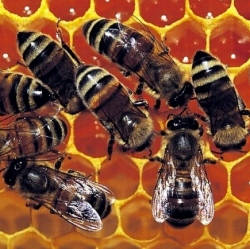
A team of researchers working on the The Green Brain Project has advanced to the point of being able to use what they’ve created in mimicking a honeybee brain, to actually pilot a flying robot drone. The aim of the project is to completely reproduce a bee’s brain in digital form, allowing at some point, a flying robot to function as the real thing.
Despite its small size, and limited thinking abilities, the brain of the bee is still an incredibly complicated piece of biology. It allows the bee to see its environment, respond to it, fly around in it and to go about its bee activities, such as mating, pollinating and stinging those that interrupt its mission. The people running the Green Brain Project chose the bee because of its remarkable ability to do so much with so little.
Thus far, the BBC reports, the team has managed to put together a rudimentary olfactory (sensory) and vision system and has begun to test what they’ve created with robots, all of which is based on such science as decision theory and neuroscience modeling and technology such as parallel computing and of course, robotics.
In their latest effort, the team has inserted their digital bee brain into the workings of an ordinary quad-copter drone, allowing the drone to fly some missions without assistance. In one case it was able to fly down a corridor without running into anything, in another it was able to recognize a checkerboard pattern on a corridor wall and to use it as a form of navigation.
The bee brain is not running the rotors directly just yet, but other teams in other parts of the world are busily attempting to create a drone that both looks and acts like a real bee, once that happens, the digital brain can be set inside and the drone/bee lookalike can be put through trials until it one day makes its way through cropland pollinating as a natural bee, perhaps taking over for the real thing as the biological kind continue to suffer colony collapse.
